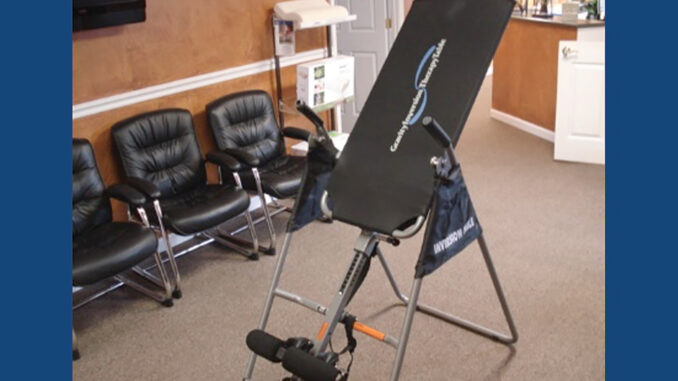
The effects of gravity on your back and body can be devastating. One way to combat this is through inversion. In this article I will go over some frequently asked questions and give a little more insight as to how and when to use an inversion table.

An inversion table is a flat, rotating table that allows you to hang upside down. While hanging upside down, it creates a gravity-assisted traction on your back and body.
People with chronic pain and stiffness in the mid to lower back often benefit the most from using an inversion table. I would not recommend it for anyone with acute inflammatory back pain, radiating pain down the legs, or anyone with neck pain.
In cases of specific lower back conditions such as previous surgeries, congenital fusions (since birth), bulging or herniated discs, moderate to severe arthritis, etc., it is best to consult with your healthcare professional before using the inversion table. Even with some of the above conditions the inversion table can still be used and be very beneficial.
An inversion table is used by strapping your ankles in and lying flat against the table. If the inversion table is set up properly for your weight and height, then raising your arms will be enough to shift your body weight and invert the table. Moving your arms back down by your side should bring the table back to an upright position. If this does not happen easily, you might need to modify the height of the table until you rotate easily.
I recommend beginners start with a slow, progressive type of inversion with only an approximate 100o-120o inversion (10o-30o beyond horizontal) for the first few weeks. Most tables have a strap you can use to limit how far you invert. By using this it will prevent you from going too far.
While inverted, gently lift your shoulders (one at a time) an inch or so off the table slowly and gently rocking back and forth. This will help you slowly stretch down the table. (WARNING: The more you stretch the more the table will want to invert. It can move very quickly if you are not prepared.)
The best way to use the inversion table is by intermittent traction. To do this, slowly invert for up to 60 seconds and then return to a position that is parallel to the floor. This way you are not loading weight back onto your spine. Remain parallel to the floor for 20 seconds before you repeat this process. This should be done in a slow manner. I recommend only inverting for a total of 8-10 minutes each session. One reason is this is plenty of time to fully stretch and traction out the back. The second reason is if you invert for too long you may strain and injure the same structures you are trying to help. You can repeat this once or multiple times per day.
At approximately 150o inversion (60o beyond horizontal), you will be inverted to the point you should be parallel with the back legs of the table. For most people, this angle will allow you to get all the benefits of inversion without fully inverting to 180o (90o beyond horizontal).
Using an inversion table should not be confused and is not the same as using a spinal decompression table in a healthcare office. Although using the inversion table gives you traction of the low back, it is much different than spinal decompression. Lumbar spinal decompression focuses directly on the lumbar discs. It uses a computerized form of traction to reach a specified amount of decompressive forces on the lumbar spinal discs.
Most inversion tables vary in durability and maximum weight capacity. Most tables will hold up to 250-300 pounds. The cost range averages from around $100 up to around $1500. I have found the less expensive inversion tables to be great. My personal inversion table was only $150 and is very easy and comfortable to use. The biggest factor is the weight capacity. You always want to follow the manufacturer’s guidelines and safety restrictions.
If you experience discomfort you may be inverting too much, too quickly, or for too long. While inverting, you are stretching muscles and ligaments that can be strained if pushed too hard.
Always keep in mind, bigger inversion angles for longer periods of time does not mean you will gain more therapeutic benefits.
Inversion tables are a fantastic way to stretch and combat the effects of gravity on the back. It can help stretch tight muscles and ligaments and relieve pressure off stressed spinal discs and vertebrae. For a minimal investment they can be a wonderful adjunct to help keep your back in great shape!
-by Dr. Brandon Crouch
About the Author: Brandon Crouch, D.C. is a Chiropractor with Crouch Family Chiropractic. He is an advocate for being proactive when it comes to your health and encourages people to make healthy, informed decisions. For more information you can go online at: www.crouchfamilychiro.com.
Disclaimers: Always consult your healthcare professional before starting any new exercise or stretching routine. If you have any serious health conditions, especially related to the heart or blood pressure, you should consult your doctor before inverting. Be sure to follow all manufacturer’s recommendations. The information contained in this article should never replace the recommendations as made by your healthcare provider or by the manufacturer and is for informational purposes only.




